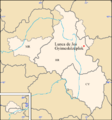Lunca de Jos (Harghita)
|
Lunca de Jos Gyimesközéplok |
||||
|
||||
| Basic data | ||||
|---|---|---|---|---|
| State : |
|
|||
| Historical region : | Transylvania | |||
| Circle : | Harghita | |||
| Coordinates : | 46 ° 34 ' N , 25 ° 58' E | |||
| Time zone : | EET ( UTC +2) | |||
| Height : | 857 m | |||
| Area : | 126.01 km² | |||
| Residents : | 5,328 (October 20, 2011) | |||
| Population density : | 42 inhabitants per km² | |||
| Postal code : | 537145 | |||
| Telephone code : | (+40) 02 66 | |||
| License plate : | MR | |||
| Structure and administration (as of 2016) | ||||
| Community type : | local community | |||
| Structure : | Lunca de Jos, Barațcoș , Poiana Fagului , Puntea Lupului , Valea Boroș , Valea Capelei , Valea Întunecoasă , Valea lui Antaloc , Valea Rece | |||
| Mayor : | Karoly Gergely ( UDMR ) | |||
| Postal address : | Str. Principală, no. 647 loc. Lunca de Jos, jud. Hunedoara, RO-537145 |
|||
| Website : | ||||
Lunca de Jos (outdated Lunca-de-mijloc , Lunca Gimeșului or Lunca Ghimeșului ; Hungarian Gyimesközéplok or Csíkgyimesközéplok ) is a municipality in Harghita County in Transylvania , Romania .
Geographical location
The municipality of Lunca de Jos is located in the east of Transylvania in the western foothills of the Tarcău Mountains - a mountain range of the Eastern Carpathians - in the historical Szeklerland . On the upper reaches of the Trotuș , the railway line Sfântu Gheorghe-Siculeni-Adjud and the Drum național 12A , the place Lunca de Jos is 37 kilometers northeast of the district capital Miercurea Ciuc .
North of Lunca de Jos, the county road ( Drum județean ) DJ 127A leads over the Dămuc pass (approx. 980 m ; ⊙ ) towards the small town of Bicaz in the Neamț district ; the national road 12A over the Ghimeş-Făget Pass to Comăneşti in Bacău County .
history
The place Lunca de Jos was first mentioned in 1850.
population
In 1850 there were 776 Magyars in the area that is now the municipality . In the next few years the number of the population rose sharply, so that in 1900 - at the same time the highest number of Germans (94) - 2632 people were counted. The highest population (5392) was reached in 1977 - at the same time that of the Serbs (4). The highest number of Magyars (5313) was reached in 1966, that of Romanians (284) and that of Roma (22) in 1930. In addition, in 1910 and 1930 one inhabitant each referred to themselves as Ukrainians , in 1930 and 1992 one inhabitant each as Serb, in 1910 three, 1930 one and 1941 two residents as Slovaks . In 2002, 5227 people lived in the community, of whom 5175 were Magyars, 42 Romanians and ten without information. The 2011 census counted 5,328 people in the municipality of Lunca de Jos.
The main occupation of the population is cattle breeding and wood processing.
Attractions
- The Roman Catholic Church Sf. Maria Magdalena , was built in Lunca de Jos in 1855 and renovated in 1927.
- A watermill, built in the 19th century (at 605 Principală Street ), is a listed building.
- In the incorporated village of Valea Rece ( Kaltbach ) two Roman Catholic wooden chapels Schimbarea la Față in the 19th and Sf. Anton in the 20th century, as well as the farms of Csillag Péter (no. 1124) in the 19th century and that of Focze Istvan (no. 822) in the 20th century are listed as historical monuments.
Web links
Individual evidence
- ↑ 2011 census in Romania at citypopulation.de
- ^ Dictionary of localities from Transylvania
- ↑ View of the Ghimeș-Făget Pass
- ↑ Heinz Heltmann, Gustav Servatius (Ed.): Travel Guide Siebenbürgen. Kraft-Verlag, Würzburg 1993, ISBN 3-8083-2019-2 .
- ↑ Census, last updated November 2, 2008, p. 43 (Hungarian; PDF; 691 kB)
- ↑ Information on the church in Lunca de Jos
- ↑ a b List of historical monuments of the Romanian Ministry of Culture, updated 2010 (PDF; 7.10 MB)
- ↑ Presentation of the wooden chapel Schimbarea la Față at biserici.org (Romanian)
- ↑ Representation of the wooden chapel Sf. Anton at biserici.org (Romanian)





